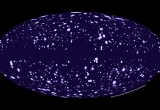ESO-LP : A Planck/ESO legacy sample of the most massive clusters

Exploiting the most massive galaxy clusters as probes of cosmology and structure formation.
Contact at IAS: Nabila Aghanim (PI)
The Planck survey is the first all-sky survey capable of blind cluster detection since the ROSAT All Sky Survey (RASS). Recently released to the general community, the Planck catalogue of Sunyaev-Zeldovich sources (PSZ) provides us with a unique sample of objects including a complete census of massive clusters (M ≥ 5 × 10¹⁴ Mʘ) out to z ~ 1 distributed across the sky. Using ESO facilities, NTT/EFOSC2 and VLT/FORS2, in a well-coordinated follow-up programme including Northern telescopes, we propose to achieve the full redshift determination of the whole PSZ clusters over the 65% cleanest sky area. Combining the redshift measurement with the SZ flux from Planck, we will estimate cluster masses for the whole catalogue, filling a unique window in the M-z space with the most massive high-redshift clusters. The evolution of the mass function of this well understood catalogue will be used to put constraints on cosmological parameters, in particular σ8 and Ωm, with an accuracy better than 1%. With such tight constraints, and in combination with CMB, SZ-selected clusters may put the most stringent limits on the neutrino mass. ESO-NTT and VLT are key facilities for the success of this programme, and their spectroscopic and photometric data will allow us to construct a lasting legacy catalogue of massive clusters for studies of galaxy clusters and the evolution of their constituent galaxies.



